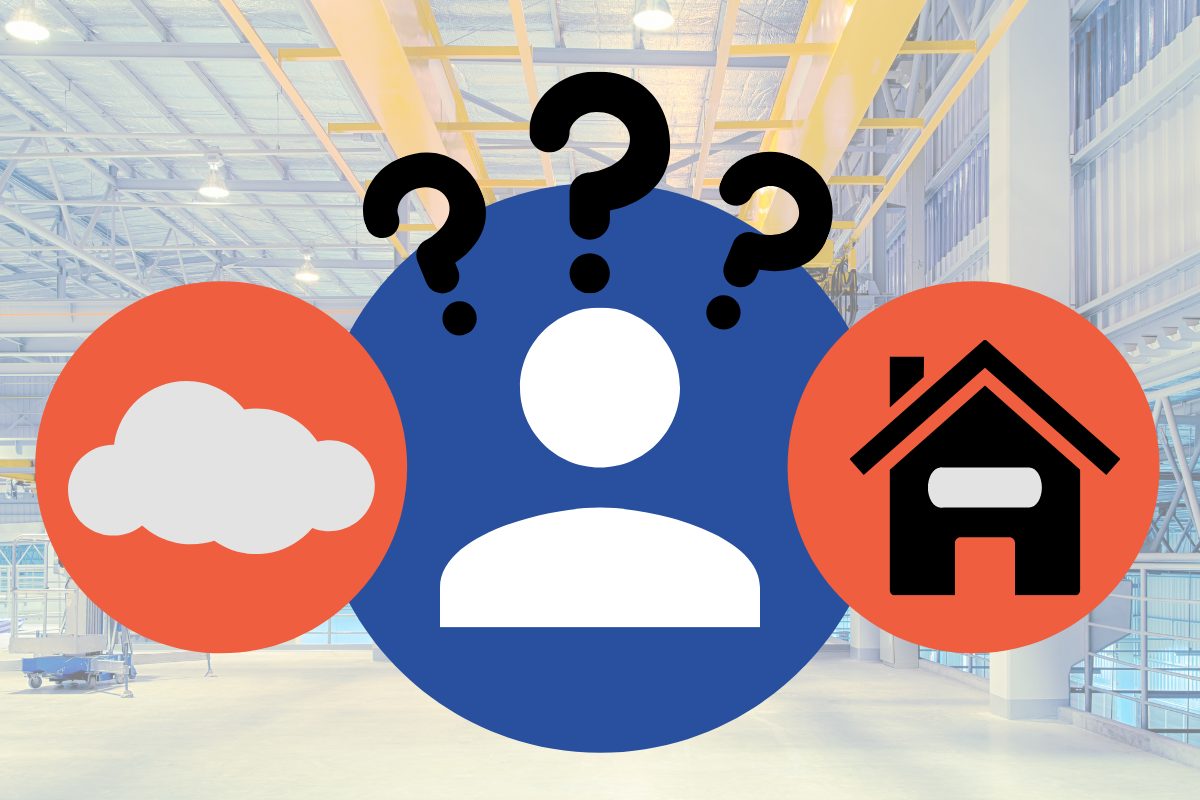On premise vs. cloud software – which solution optimizes manufacturing?
In today’s world of enterprise IT, the question is how companies want to build their software infrastructure. There are two different options for this – on premise vs. cloud. In the following you will learn more about the differences and respective advantages and disadvantages of the two options.
Every company needs software to organize their work processes. In the past, there were only traditional on premise solutions. But as digitization progressed, a new alternative emerged – the cloud.
Definition
“On premise” means “on one’s own premises” or “on site”. Consequently, the software system is stored on the company’s own servers. The software has to be purchased by the company in form of licenses in order to use it.
A cloud solution, on the other hand, works according to the “software as a service” principle. The company rents external servers to store its data. Consequently, opting for a cloud solution describes a kind of outsourcing of the company’s software.
Advantages and disadvantages
In order to make the right choice as a company, the advantages and disadvantages of the two solutions have to be considered.
On premise software
On premise solutions offer the advantage that the company retains the complete control over their software on site. In addition, an important point of the differentiation between the two solutions is the internet connection. On premise solutions, contrary to the cloud solution, do not require internet access to access data.
The disadvantages of an on premise software solution are the associated high acquisition costs for the required hardware and license fees. Companies have to purchase servers by themselves to store their software on them.
In addition, IT staff has to be available for service requests when problems arise. In general, emerging maintenance issues can drive up the cost factor exponentially.
Cloud software
The advantage of choosing a cloud is that it eliminates the acquisition costs of company-owned hardware. A cloud provider hosts the company’s data on a cloud-based server. The only costs to be taken into account are the rental costs, which are usually not that high.
Additionally, the company does not need any special IT staff, since updating and maintenance are handled by the software provider itself. Due to the immediate provision of access, cloud solutions eliminate both, the time required for implementation and the associated costs.
Thanks to the internet connection of cloud software, data access is possible from anywhere. The company can reliably access data from anywhere in the world with an existing internet connection.
However, the cloud solution can also bring problems. When the support for the current version expires, new costs can arise for a necessary update. Another factor is data protection. When the company chooses a cloud solution, it gives away a lot of sensitive data to the software provider.
What on the one hand enables data access from anywhere in the world also has a disadvantage. Since cloud solutions require internet access, if the internet connection is not available, the data is not accessible. These factors include some dependency when deciding on a cloud solution.
There are some reasons for opting for an on premise solution as well as against it. The same is true when deciding on a cloud solution. Companies need to ask themselves if giving up complete control of their data, with reduced costs as a result, is the deciding factor. The following is about choosing the best software in manufacturing.
Cloud software in manufacturing
Today, the need for cloud solutions in industrial manufacturing is undisputed. The advantages for manufacturing companies are obvious. With the increasing pressure of shorter time-to-market cycles, high quality requirements as well as more complex supply chains can hardly be managed with traditional on premise solutions.
Using cloud solutions in manufacturing promises above all greater scalability and agility. Furthermore, manufacturing processes can be optimized by cloud solutions and made more transparent across different locations and plants.
The goal of cloud-based production is to make all production-relevant data available to every employee in real time. This enables the company to provide exactly the data that is needed for the respective tasks of the production employees.
By optimizing the user interface, it can be tailored individually to each employee. This puts the user in the center of software and hardware.
An important decision criteria in the area of manufacturing is data security when integrating cloud software. How secure is the transfer of data to third parties and can data manipulation or loss occur during the process?
When a company decides to implement a cloud solution, it shares its data with third parties, the cloud providers. In order to minimize the risk of passing on sensitive data, obligations for cloud providers have been set out in the GDPR. These contain necessary minimum requirements which are intended to protect the user of the cloud.
This covers ensuring sufficient encryption and backup options. Moreover, users have the right to get information, correction, transfer and deletion of their data at any time.
In addition, we recommend the following 5 protective measures to counter cyber attacks:
- Sensitization of employees in IT security
- Updated high security standards and architectures
- Appropriate work equipment for employees
- Use of security and anti-ransomware technology
- Managed security services
Current status
The current progress and use of cloud solutions varies depending on the industry and production company. Cloud software is already being used in many ways, especially in the manufacturing areas of quality management and asset performance management.
In the future, it is important to stay tuned. The more the production becomes digitalized, the more important the use of cloud software becomes for manufacturing companies. Especially in the course of emerging trends such as the smart factory, IoT and digital supply chains, there will be no getting around cloud software for any company in the long term.
Would you like to make your production more efficient?
Contact us now and receive comprehensive advice.
[hubspot portal=”7001161″ id=”c6455fcf-e396-470a-b110-05dc444a0c98″ type=”form”]
